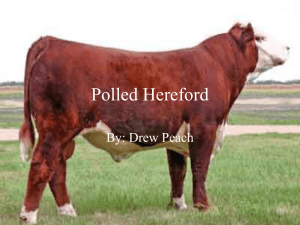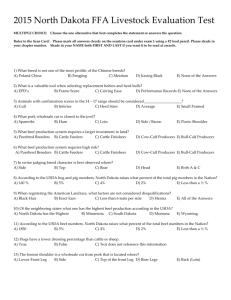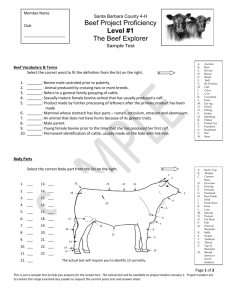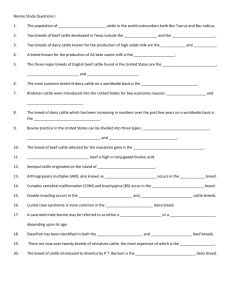Exploring the Beef Industry
advertisement
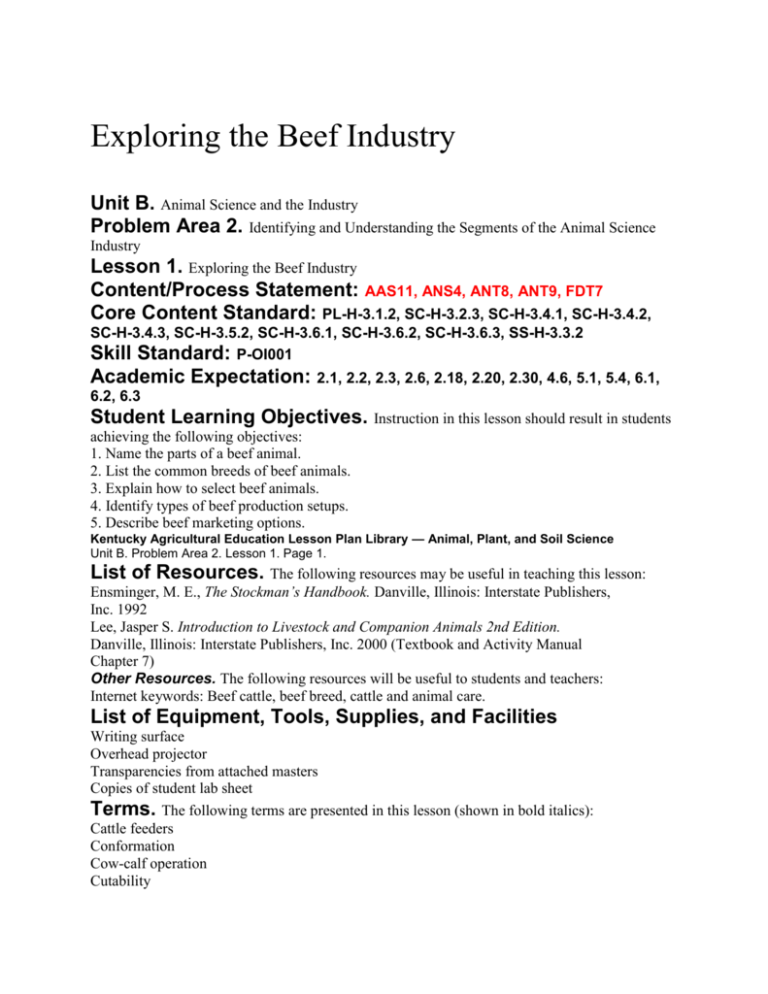
Exploring the Beef Industry Unit B. Animal Science and the Industry Problem Area 2. Identifying and Understanding the Segments of the Animal Science Industry Lesson 1. Exploring the Beef Industry Content/Process Statement: AAS11, ANS4, ANT8, ANT9, FDT7 Core Content Standard: PL-H-3.1.2, SC-H-3.2.3, SC-H-3.4.1, SC-H-3.4.2, SC-H-3.4.3, SC-H-3.5.2, SC-H-3.6.1, SC-H-3.6.2, SC-H-3.6.3, SS-H-3.3.2 Skill Standard: P-OI001 Academic Expectation: 2.1, 2.2, 2.3, 2.6, 2.18, 2.20, 2.30, 4.6, 5.1, 5.4, 6.1, 6.2, 6.3 Student Learning Objectives. Instruction in this lesson should result in students achieving the following objectives: 1. Name the parts of a beef animal. 2. List the common breeds of beef animals. 3. Explain how to select beef animals. 4. Identify types of beef production setups. 5. Describe beef marketing options. Kentucky Agricultural Education Lesson Plan Library — Animal, Plant, and Soil Science Unit B. Problem Area 2. Lesson 1. Page 1. List of Resources. The following resources may be useful in teaching this lesson: Ensminger, M. E., The Stockman’s Handbook. Danville, Illinois: Interstate Publishers, Inc. 1992 Lee, Jasper S. Introduction to Livestock and Companion Animals 2nd Edition. Danville, Illinois: Interstate Publishers, Inc. 2000 (Textbook and Activity Manual Chapter 7) Other Resources. The following resources will be useful to students and teachers: Internet keywords: Beef cattle, beef breed, cattle and animal care. List of Equipment, Tools, Supplies, and Facilities Writing surface Overhead projector Transparencies from attached masters Copies of student lab sheet Terms. The following terms are presented in this lesson (shown in bold italics): Cattle feeders Conformation Cow-calf operation Cutability Demand Dual-purpose breed Desirable traits Feeder calves Frame score Marbling Performance Polled Purebred breeders Supply Yearling feeders Summary of Content and Teaching Strategies Objective 1: Name the parts of a beef animal. Anticipated Problem: What are all the parts of a beef animal? I. Since the main purpose of beef cattle is for meat consumption, we look at them not only to identify their basic parts, but also to identify the beef cuts on an animal. A. There are many external parts of beef cattle that you must know in order to speak the language when judging or selecting one beef animal over another. These are general parts like eyes, head, tail, belly, and back. B. There are also many terms you should know in reference to beef cuts that are taken from an animal. These are meat terms like loin, sirloin, stew meat, and short ribs. Objective 2: List the common breeds of beef animals. Anticipated Problem: What are the common breeds of beef animals? II. The common breeds of beef animals in the United States were brought here from many different countries. They include Angus, Charolais, Hereford, Polled Hereford, Limousin, Shorthorn, Simmental, Brahman, Brangus, and Beefmaster. A. Aberdeen-Angus cattle known here as Angus cattle originated in the northeast of Scotland and were brought to the U.S. in the 1870s. Angus are the most popular purebred beef cattle partially because they are vigorous and perform well in feedlots. This animal is polled or born naturally without horns. They are moderate in size compared to other breeds and are solid black or red. The red animals do not absorb as much heat as the black ones, making them more heat tolerant. Angus cattle are known for their marbling, which is the desirable presence of fat in the muscle. The American Angus Association has been active since 1883 and has not allowed red calves to be registered since 1917. It was not until 1954 that the Red Angus Association was formed. B. The Charolais originated in the province of Charolais, France. They have pink skin and are white to light straw colored. The breed is large in comparison to others with the bulls weighing 2,000 to 2,500 pounds at maturity and the mature cows weighing 1,500 to 1,800 pounds. The Charolais can be polled or horned animals and are known for their heavy muscling. This breed is popular to crossbreeding programs to increase size and muscle in offspring of other breeds. C. Hereford cattle originated in Hereford County, England. In the U.S., the first known purebred herd was established in 1840 in New York. Hereford cattle have white faces and red bodies with white markings on the switch, underline, below the hocks, and on both their crest and flank. They are tolerant to cold climates because of their thick coats. The breed is horned and easy to handle because of their moderate size and docile nature. Polled Hereford animals were started in Iowa by Warren Gammon who gathered animals that were naturally polled and bred them to make more polled animals. Polled Herefords have the same traits as Herefords and are eligible for registry in both the American Hereford Association and the American Polled Hereford Association. D. The Limousin originated in southwestern France. Limousin semen from Canada was brought to the U.S. in 1968. The breed is wheat to rust red or orange colored with the area around the muzzle a lighter version of the body color. Limousin have both polled and horned cattle and recently, black lines of cattle have been developed. The breed is long and shallow bodied and is known for calving ease. The cattle are also know for the leanness of their carcass and large loin areas. The cutability or the amount of available retail cuts from the carcass is high in Limousin. E. The Shorthorn is a dual-purpose breed meaning that they have been traditionally used for both milk and beef production. They originated in England and were named because of breeding practices that shortened the horns of this breed. Shorthorn cattle can be red, white, or roan colored and either horned or polled. They are short and are known to be docile animals with good mothering abilities. Both horned and polled animals can be registered with the American Shorthorn Association, which was organized in 1872. F. The Simmental originated in western Switzerland where it derived its name from the Simme Valley. The breed is very old, dating back to the Middle Ages, but they have only been in the U.S. since 1969, when they were brought here from Canada. The color pattern includes a white face that is dominant and a red and white spotted or nearly solid red body. Black strains of this breed have also been developed. Both polled and horned animals exist and the breed is known for rapid growth, thick muscling, and adaptability to many different climates. G. The Brahman originated in the U.S. after several animals were imported from India and bred to several British breeds. The Brahman was commonly used in crossbreeding programs, which led to the development of many desirable hybrids. The coloring can be light gray or red and sometimes almost black. It is easy to recognize a Brahman because of its loose skin, large hump over the shoulders, and large drooping ears. Sometimes called Zebu, Brahman cattle are popular because of their resistance to disease and insects, tolerance to heat, rapid weight gain, and quality carcasses. The breed is unpredictable in temperament, but has an excellent ability to forage successfully on poor range. H. The Brangus is a cross of Brahman and Angus based on foundation stock that is 3/8 Brahman and 5/8 Angus. Brangus are polled animals and their color is solid black. Because of their genetics they have many of the same characteristics of the Angus and Brahman animals. I. Beefmaster cattle were developed in Texas by combining ½ Brahman, ¼ Shorthorn, and ¼ Hereford. Coloration varies, but red is the dominant color. Beefmaster can be horned or naturally polled. The breed is very hardy and is known to milk well. Beefmaster cattle are popular because of their good temperaments, hardiness, heavy weaning weights, and rapid weight gain. . Objective 3: Explain how to select beef animals. Anticipated Problem: How do I know what beef animals are better than others? III. In order to improve your herd, you must be able to select animals with more desirable traits. Desirable traits are traits that are in demand at the marketplace. Mainly, selection is based on conformation and performance records. Conformation describes the shape, form, and type of an animal. Performance describes the ability of an animal to reproduce, wean, gain weight, and stay strong. A. One way to select animals to bring into a herd is a frame score. The frame score is a measurement based on animals being observed and evaluated at 205 days. A one through seven scale is used to determine the frame score. B. A conformation score may also be determined on an animal on a scale of 1–17. The scoring of 9–11 is below average, 12–14 is average, and 15–17 is above average. C. When selecting animals, you must realize that no one breed is going to be superior in all traits. You need to decide what your individual priorities are and select a breed based on them. In addition to selection, you must commit to good management practices in order to keep the cattle superior. Good management will include keeping diets nutritious, making comfortable living conditions, continually monitoring animals for health concerns, and constant assessment of better breeding stock. D. The final consideration when selecting animals to improve your herd is choosing reputable producers. This will help insure animals relatively free from disease and genetic problems and you will be able to look at records of the animal to determine if it will be profitable to your herd. Objective 4: Identify types of beef production setups. Anticipated Problem: What type of production best suits my needs? IV. There are three main types of beef production setups. The first type is cow-calf producers. The second is feeders or feedlots and the third is purebred breeding. Before you decide what type of setup is best for you, make sure that you analyze all the advantages and disadvantages of producing beef to make sure it is the most profitable way to utilize your resources. You may also want to look at your local market and decide what supply and demand issues you may face. A. A cow-calf operation consists of keeping mature cattle to produce calves to sell to other producers. Cows are bred in this setup to have a calf every year, usually in late winter or early spring. TCalves are sold in two ways. Feeder calves are weaned animals under a year old that are fed until they are sold to a feedlot, where they are kept and fed to slaughter weights. Yearling feeders are calves between 1 and 2 years old that are sold to another producer to feed out to slaughter weight or finish. Cow-calf operations utilize pastures for grazing through the growing months and are less labor intensive than other operations. It is easy to start an operation because of low investment costs. These setups require very little equipment and facilities and can be especially beneficial when land that is not suited for crops is used. Another advantage is that you can increase your herd by keeping animals back each year—you don’t have to keep buying more animals. Some disadvantages of cow-calf operations are the large initial land investment, not being able to make a profit because the demand for calves is low when you are ready to sell, and problems associated with weaning or size of calves. In the cow-calf business you must also realize that there will be a long amount of time that goes by without a paycheck. You must budget for feed, minerals, vet bills, and other common expenses during that time. B. Cattle feeders are producers that feed beef animals out for the slaughter market. Owners usually buy yearlings or feeder calves and try to finish them in as little time as possible. The initial investment is high for this type of operation because of the need for high quality feed and the housing and equipment needs. The production lag is less than in a cow-calf operation because you can expect to turn the animals in 4–6 months. In addition to higher feed, housing, and equipment expenses, labor and trucking costs are also high. With all the expenses and need for quick turnover time, it is essential to be a good manager in a cattle feeder operation. Fluctuating market prices also present a risk. C. Purebred breeders are producers that keep herds for purebred breeding stock and provide replacement bulls or semen for cow-calf operations. Their stock provides genetic improvement to herds. The initial start up costs of purebred breeders are high because genetically superior animals are more expensive than average animals. Another large investment is the time it may take to develop high quality animals. It will sometimes take years to show the success of an animal by keeping records of its offspring. It takes a very knowledgeable manager to run a profitable purebred operation. Objective 5: Describe beef marketing options. Anticipated Problem: What marketing options do I have with beef cattle? V. Depending on your type of operation and location, you may have many marketing options, or you may be limited with what you can do. No matter how you decide to market your product, you will always see the laws of supply and demand governing the market price. Supply is the overall amount of product available at any given time. Demand is the amount that could be purchased at a given time for a given price. There are seasonal pricing patterns that you can watch to help you decide when to market your animals for the best possible profit. Since there are several ways to market beef cattle, you need to determine which one is best for you based on marketing costs, the convenience of the market, and market price. A. Purebred marketing of cattle is one way of marketing your beef cattle. The sale of purebred animals tends to be done privately or at auctions. Sometimes breed associations hold consignment auctions. If you choose to market animals this way, you will need to consider advertising costs and the payment of the auctioneer when figuring profit. B. Local sale barns are popular because of their convenience to buyers. Many small producers utilize this market because they are near by and the selling fees are either based on a percent of sale or a fixed amount. In a sale barn situation, feeder and slaughter cattle go to the highest bidder. C. Another way to market cattle is to sell them directly. Many larger producers use direct selling to avoid paying a commission or brokers. Almost 70 percent of slaughter cattle going to packers come from direct markets. COMMON BREEDS OF BEEF ANIMALS IN THE UNITED STATES • Angus • Charolais • Hereford • Polled Hereford • Limousin • Shorthorn • Simmental • Brahman • Brangus • Beefmaster ANIMAL SELECTION FOR HERD IMPROVEMENT • Desirable traits are traits that are in demand at the marketplace. Mainly, selection is based on conformation and performance records. • Conformation describes an animal’s shape, form, and type. • Performance describes the ability of an animal to reproduce, wean, gain weight, and stay strong. • Frame score is a measurement based on animals being observed and evaluated at 205 days. • When selecting animals, you must realize that no one breed is going to be superior in all traits. You need to decide what your individual priorities are and select a breed based on your resources. • Choosing reputable producers will help insure animals free from disease, genetic problems. BEEF PRODUCTION OPERATIONS Cow-calf • Advantages: Disadvantages: Cattle feeders • Advantages: Disadvantages: Purebred breeders • Advantages: Disadvantages:
